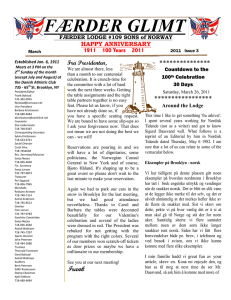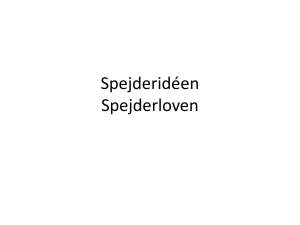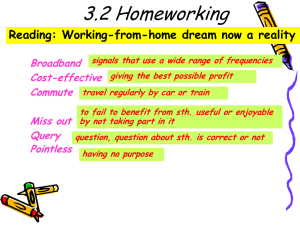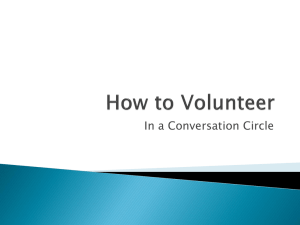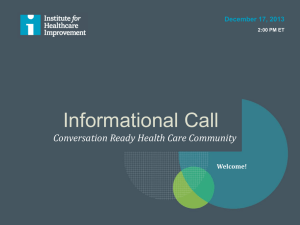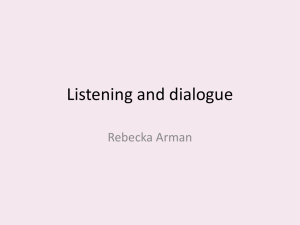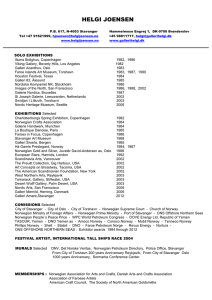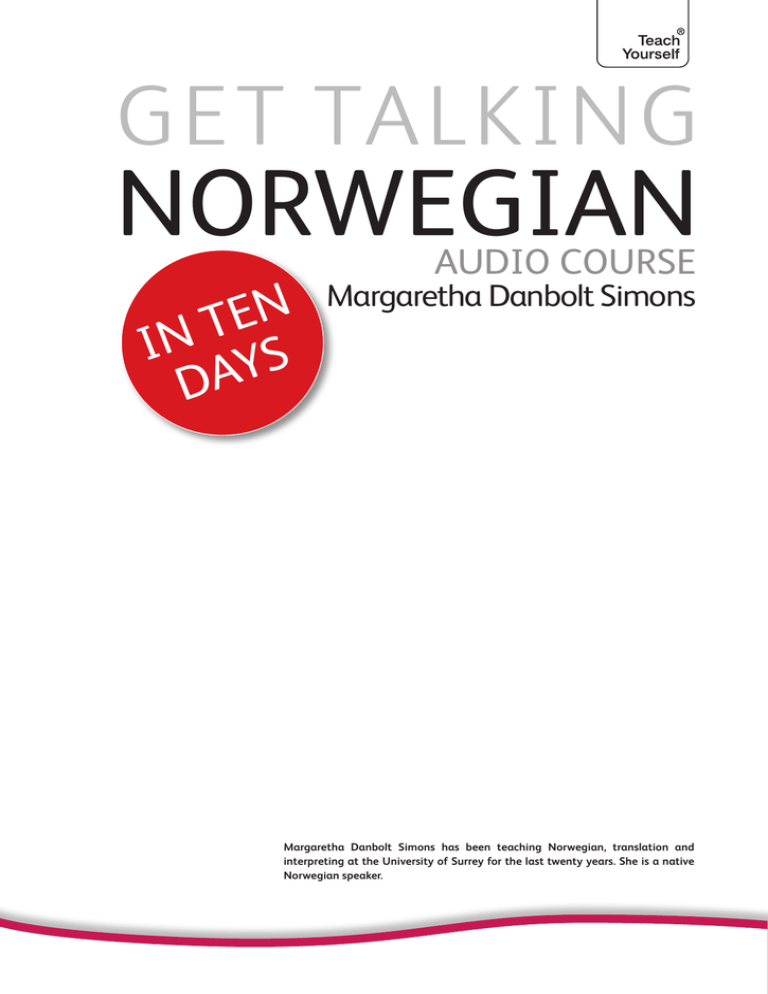
get talking
Norwegian
n
e
t
n
i
s
y
a
d
Audio Course
Margaretha Danbolt Simons
Margaretha Danbolt Simons has been teaching Norwegian, translation and
interpreting at the University of Surrey for the last twenty years. She is a native
Norwegian speaker.
Hodder Education
338 Euston Road, London NW1 3BH.
Hodder Education is an Hachette UK company
First published in UK 2012 by Hodder Education.
First published in US 2012 by The McGraw-Hill Companies, Inc.
Based on original conversations from Teach Yourself Norwegian Conversation
and Speak Norwegian with Confidence.
Copyright © 2012 Margaretha Danbolt Simons
The moral rights of the author have been asserted
Database right Hodder Education (makers)
The Teach Yourself name is a registered trademark of Hachette UK.
All rights reserved. No part of this publication may be reproduced, stored in
a retrieval system or transmitted in any form or by any means, electronic,
mechanical, photocopying, recording or otherwise, without the prior permission
in writing of Hodder Education, or as expressly permitted by law, or under
terms agreed with the appropriate reprographic rights organization. Enquiries
concerning reproduction outside the scope of the above should be sent to the
Rights Department, Hodder Education, at the address above.
You must not circulate this book in any other binding or cover and you must
impose this same condition on any acquirer.
British Library Cataloguing in Publication Data: a catalogue record for this title is
available from the British Library.
Library of Congress Catalog Card Number: on file.
10 9 8 7 6 5 4 3 2 1
The publisher has used its best endeavours to ensure that any website addresses
referred to in this book are correct and active at the time of going to press.
However, the publisher and the author have no responsibility for the websites
and can make no guarantee that a site will remain live or that the content will
remain relevant, decent or appropriate.
The publisher has made every effort to mark as such all words which it believes
to be trademarks. The publisher should also like to make it clear that the
presence of a word in the book, whether marked or unmarked, in no way affects
its legal status as a trademark.
Every reasonable effort has been made by the publisher to trace the copyright
holders of material in this book. Any errors or omissions should be notified in
writing to the publisher, who will endeavour to rectify the situation for any
reprints and future editions.
Hachette UK’s policy is to use papers that are natural, renewable and recyclable
products and made from wood grown in sustainable forests. The logging
and manufacturing processes are expected to conform to the environmental
regulations of the country of origin.
www.hoddereducation.co.uk
Cover image © Poula Hansen / iStockphoto.com
Typeset by Integra Software Services Pvt. Ltd., Pondicherry, India.
y
a
D
1
Introducing
yourself
Today you will learn how to do the following:
CCintroduce yourself
CCtalk about where you live and
CCtell people if you’re on holiday
Part 1
Track 3
Here are the key phrases you’ll hear in today’s conversation. Listen to the English meaning. Then, listen to the
Norwegian expressions and repeat.
CC English expressionsc Norwegian expressions
Hi! What are you called? (Hi! What is your name?)
I’m called Olav. (My name is Olav.)
Do you live in Oslo?
No, I live in Bergen.
Are you on holiday here?
Yes, I’m on holiday here.
No, I live here.
Hei! Hva heter du?
Jeg heter Olav.
Bor du i Oslo?
Nei, jeg bor i Bergen.
Er du på ferie her?
Ja, jeg er på ferie her.
Nei, jeg bor her.
Language tip!
Remember to get the endings
of words right in Norwegian.
It’s a good idea to practise
them again, especially the
words jeg, heter and ferie.
Part 2
Listen carefully to a conversation between Olav and a girl he has just met. Then answer the questions below.
Track 4
1. Does Olav live in Oslo?
2.Is Olav on holiday?
Part 3
Listen to the conversation again and answer the questions.
Track 5
1. What’s the name of the girl?
2. Where does the girl live?
Language tip!
In Norwegian, the phrase to do is
not used when asking questions or
in negative statements. Here, when
Kari asks Olav if he lives in Oslo, she
literally says Live you in Oslo?
Part 4
Track 6
Now listen to the conversation again. Answer the questions about the meanings of certain words. Then, practise
using the expressions.
1. What does Hei mean?
2. Which words mean yes and no?
3. What does ferie mean?
Get Talking Norwegian In Ten Days © HODDER & Stoughton LTD 2012
1
Part 5
Track 7
Now it’s time to learn more words for saying Hello and greeting people. Listen to the English words and repeat
the Norwegian expressions.
CC English expressionsc Norwegian expressions
Hello.Hallo!
Good day.
God dag.
How are you?
Hvordan har du det?
I’m good, thanks.
Jeg har det bra, takk.
Learning Plus!
Negative statements and Where do you live
Track 8
When answering questions about where you live, you may want to make negative statements. In English we
make most negative statements with do and not. In Norwegian you don’t use do, just the word for not.
Listen to the English words and repeat the Norwegian expressions.
CC English expressionsc Norwegian expressions
not
I don’t live in Oslo.
I am not on holiday.
Where do you live?
I live in England.
ikke
Jeg bor ikke i Oslo.
Jeg er ikke på ferie.
Hvor bor du?
Jeg bor i England.
Conversation Script
CC Norwegian conversation
CC English translation
Olav
Hei! Hva heter du?
Olav
Kari
Kari. Hva heter du?
KariKari. What is your name?
Olav
Jeg heter Olav.
Olav
My name is Olav. (Literally, I am called
Olav.)
Kari
Bor du i Oslo?
Kari
Do you live in Oslo?
Olav
Nei, jeg bor i Bergen.
OlavNo, I live in Bergen.
Kari
Er du på ferie her?
KariAre you on holiday here?
Olav
Ja, jeg er på ferie her. Er du
på ferie?
Olav
Kari
Nei, jeg bor her.
KariNo, I live here.
Hi! What is your name? (Literally, What
are you called?)
Yes, I am on holiday here. Are you on
holiday here?
Audio Track Information
Track 3
Track 4
Track 5
Track 6
Track 7
Track 8
Conversation 1, Part 1
Conversation 1, Part 2
Conversation 1, Part 3
Conversation 1, Part 4
Conversation 1, Part 5
Conversation 1, Learning Plus!
Get Talking Norwegian In Ten Days © HODDER & Stoughton LTD 2012
2
y
a
D
2
Making a
telephone call
Today you will learn how to do the following:
CCmake a date
CCsay the days of the week and
CClearn to use the expression I would like to . . .
Part 1
Track 9
Here are the key phrases you’ll hear in today’s conversation. Listen to the English meaning. Then, listen to the
Norwegian expressions and repeat.
CC English expressionsc Norwegian expressions
It’s Olav.
Det er Olav.
I would like to meet you.
Jeg vil gjerne treffe deg.
Not today.
Ikke i dag.
Why not?
Hvorfor ikke?
It is Friday today. I work.Det er fredag i dag. Jeg
jobber.
How about tomorrow?
Hva med i morgen?
I’d be happy to meet you.
Jeg vil gjerne treffe deg.
Language tip!
It’s important to get
the intonation and
pronunciation correct in
Norwegian. Make sure you
practise the important
phrases.
Part 2
Listen carefully to a conversation between Olav and Kari. Then answer the questions below.
Track 10
1. What day is it?
2. Which day will Olav and Kari have lunch?
Part 3
Listen to the conversation again and answer the questions.
Track 11
1.Is Kari working today?
2.Is Kari working tomorrow?
Language tip!
Jeg vil gjerne . . . , which means I would
like to . . . , is such a useful expression.
You will hear it a lot in Norwegian. In
this conversation, both Olav and Kari
say Jeg vil gjerne treffe deg, meaning
I would like to meet you.
Part 4
Track 12
Now listen to the conversation again. Answer the questions about the meanings of certain words. Then, practise
using the expressions.
1. What does Jeg vil gjerne treffe deg mean?
2. What does Ikke i dag mean?
3. What does fint mean?
Part 5
Track 13
Now it’s time to learn the days of the week and practise some sentences using them. Listen to the English
translations and repeat the Norwegian expressions.
Get Talking Norwegian In Ten Days © HODDER & Stoughton LTD 2012
3
CC English expressionsc Norwegian expressions
Sundaysøndag
Monday mandag
Tuesdaytirsdag
Wednesdayonsdag
Thursdaytorsdag
Fridayfredag
Saturdaylørdag
It’s Sunday today.
Det er søndag i dag.
Today it is Sunday.
I dag er det søndag.
It’s Monday tomorrow.
Det er mandag i morgen.
Which day it is today?
Hvilken dag er det i dag?
Which day is it tomorrow?
Hvilken dag er det i morgen?
It is Tuesday tomorrow.
Det er tirsdag i morgen.
Learning Plus!
Making polite requests and expressing wants
Track 14
Listen to the English words used when making polite requests and expressing wants and repeat the Norwegian
expressions using jeg vil gjerne.
CC English expressionsc Norwegian expressions
Jeg vil gjerne . . .
Jeg vil gjerne ha en kopp kaffe.
Jeg vil gjerne gå til hotellet.
Jeg vil gjerne bo i Norge.
Jeg vil gjerne treffe deg.
Jeg vil gjerne treffe deg for lunsj.
I would like to . . .
I would like a cup of coffee.
I would like to go to the hotel.
I would like to live in Norway.
I would like to meet you.
I would like to meet you for lunch.
Conversation Script
CC Norwegian conversation
CC English translation
Kari
Hallo!
Kari
Hello!
Olav
Hei! Det er Olav.
Olav
Hi! It is Olav.
Kari
Hei Olav!
Kari
Hi, Olav!
Olav
Jeg vil gjerne treffe deg.
Olav
I would like to meet you.
Kari
Ikke i dag.
Kari
Not today.
Olav
Hvorfor ikke?
Olav
Why not?
Kari
Det er fredag i dag. Jeg jobber.
Kari
It is Friday today. I work.
Olav
Hva med i morgen?
Olav
How about tomorrow?
Kari
Fint! Det er lørdag i morgen. Jeg jobber
ikke.
Kari
Fine! It is Saturday tomorrow.
I don’t work..
Olav
Fint! Lunsj?
Olav
Fine! Lunch?
Kari
Ja. Jeg vil gjerne treffe deg
Kari
Yes. I’d be happy to meet you.
Audio Track Information
Track 9
Track 10
Track 11
Track 12
Track 13
Track 14
Conversation 2, Part 1
Conversation 2, Part 2
Conversation 2, Part 3
Conversation 2, Part 4
Conversation 2, Part 5
Conversation 2, Learning Plus!
Get Talking Norwegian In Ten Days © HODDER & Stoughton LTD 2012
4
y
a
D
3
Arranging
to meet
Today you will learn how to do the following:
CCuse expressions to decide when to meet
CCuse expressions to say where to meet and
CCsay goodbye
Part 1
Track 15
Here are the key phrases you’ll hear in today’s conversation. Listen to the English meaning. Then, listen to the
Norwegian expressions and repeat.
CC English expressionsc Norwegian expressions
When shall I meet you?
Two o’clock?
Where shall I meet you?
By the Parliament building.
Goodbye.
Når skal jeg treffe deg?
Klokken to?
Hvor skal jeg treffe deg?
Ved Stortinget.
Ha det bra. / Hei Hei
Language tip!
Both ways of saying
goodbye used in this
conversation, Ha det bra
and Hei Hei, are used in
informal situations.
Part 2
Listen carefully to a conversation between Olav and Kari. Then answer the questions below.
Track 16
1. Who suggests the time to meet?
2. Who suggests where they are going to meet?
Part 3
Listen to the conversation again and answer the questions.
Track 17
1. Who uses Ha det bra?
2. Who uses Hei hei?
Part 4
Track 18
Now listen to the conversation again. Answer the questions about the meanings
of certain words. Then, practise using the expressions.
Language tip!
It’s a good idea to get
familiar with the question
words what, why, when and
where in Norwegian. These
question words are very
useful when you want to find
out about the person you
have met.
1. What do the words når, and hvor mean?
2. What does Klokken to mean?
3. When would you say Jeg skal treffe deg ved Stortinget i morgen?
Part 5
Track 19
Now it’s time to learn more expressions you’ll use to make plans. Listen to the English words and repeat the
Norwegian translations.
Get Talking Norwegian In Ten Days © HODDER & Stoughton LTD 2012
5
CC English expressionsc Norwegian expressions
Goodbye.
Hei hei.
Goodbye. (Have it well.)
Ha det bra.
Have it!
Ha det!
Goodbye. (Adieu.)Adjø.
How many is the clock?
Hvor mange er klokken?
(What time is it?)
The clock is five. (It is five o’clock.)
Klokken er fem.
I shall not meet you at two o’clock.
Jeg skal ikke treffe deg klokken to.
I shall not meet you by the Parliament building.
Jeg skal ikke treffe deg ved Stortinget.
Learning Plus!
Practicing times
Track 20
Norway uses the 24-hour clock. Practise the numbers to 24. Then, listen to the English words used when saying
times and repeat the Norwegian translations.
1en
13tretten
2
to
14fjorten
3
tre
15femten
4fire
16seksten
5
fem
17sytten
6seks
18atten
7
sju
19nitten
8åtte
20tjue
9ni
21tjueen
10ti
22tjueto
11
elleve
23tjuetre
12
tolv
24tjuefire
CC English expressionsc Norwegian expressions
half to three / 2:30
five to four / 3:55
ten past 7 / 7:10
Halv tre
fem på fire
ti over sju
One big difference between English and Norwegian is that Half seven means half to seven, not
half past seven.
Conversation Script
CC Norwegian conversation
CC English translation
Olav
Når skal jeg treffe deg?
Olav
Kari
Klokken to?
KariTwo o’clock?
Olav
Hvor skal jeg treffe deg?
Olav
Where shall I meet you?
Kari
Ved Stortinget.
Kari
By the Parliament building.
Olav
Fint. Jeg skal treffe deg ved Stortinget i
morgen.
Olav
Fine. I shall meet you by the Parliament
building tomorrow.
Kari
OK. Jeg skal treffe deg i morgen
klokken to.
Kari
OK. I shall meet you tomorrow at two
o’clock.
Olav
Ha det bra!
OlavGoodbye!
Kari
Hei hei.
KariGoodbye.
When shall I meet you?
Get Talking Norwegian In Ten Days © HODDER & Stoughton LTD 2012
6
Audio Track Information
Track 15
Track 16
Track 17
Track 18
Track 19
Track 20
y
a
D
4
Conversation 3, Part 1
Conversation 3, Part 2
Conversation 3, Part 3
Conversation 3, Part 4
Conversation 3, Part 5
Conversation 3, Learning Plus!
Going to
a café
Today you will learn how to do the following:
CCsay what you like to eat
CCorder food and
CCsay what you don’t like
Part 1
Track 21
Here are the key phrases you’ll hear in today’s conversation. Listen to the English meaning. Then, listen to the
Norwegian expressions and repeat.
CC English expressionsc Norwegian expressions
I’m hungry.
I’m thirsty.
I would like to have . . .
an open sandwich with smoked salmon
a Danish pastry
Will you have coffee?
I would rather have tea.
Thank you. / No, thank you.
I like coffee.
Jeg er sulten.
Jeg er tørst.
Jeg vil gjerne ha . . .
et smørbrød med røkelaks
et wienerbrød
Vil du ha kaffe?
Jeg vil heller ha te.
Takk. / Nei, takk.
Jeg liker kaffe.
Language tip!
Notice that the familiar
phrase Jeg vil gjerne is used
here to express food and
drink preferences.
Part 2
Track 22
Listen carefully to a conversation between Olav and the new girl named Eva that he has just met and is sitting
at a café with. Then answer the questions below.
1. Who is hungry?
2. Who is thirsty?
Part 3
Listen to the conversation again and answer the questions.
Track 23
1. What does Eva want to drink?
2. What does Olav want to drink?
Language tip!
When you’re ordering food
in Norwegian, you don’t use
of. So instead of saying a
cup of coffee you literally
say a cup coffee.
Get Talking Norwegian In Ten Days © HODDER & Stoughton LTD 2012
7
Part 4
Track 24
Now listen to the conversation again. Answer the questions about the meanings of certain words. Then, practise
using the expressions.
1. What do sulten and tørst mean?
2. What is the Norwegian word for open sandwich?
3. What does og mean?
Part 5
Track 25
Now it’s time to learn more useful words when visiting a café or restaurant. Listen to the English words and
repeat the Norwegian expressions.
CC English expressionsc Norwegian expressions
hot chocolatesjokolade
beer or lagerøl
winevin
fishfisk
meatkjøtt
I would like . . .
Jeg vil gjerne ha . . .
I would like a coffee.
Jeg vil gjerne ha kaffe.
I would like a tea.
Jeg vil gjerne ha te.
I like . . .
Jeg liker . . .
I like fish.
Jeg liker fisk.
I don’t like . . .
Jeg liker ikke . . .
I don’t like meat.
Jeg liker ikke kjøtt.
Learning Plus!
Other ways to order food
Listen to the English words used when saying times and repeat the Norwegian expressions.
Track 26
CC English expressionsc Norwegian expressions
May I have / May I get
May I have a coffee?
May I have a Danish pastry?
Kan jeg få
Kan jeg få kaffe?
Kan jeg få et wienerbrød?
You should also note that Norwegian is a gender language. This means that all nouns have a gender, either
what we call common gender or neuter. The et is the indefinite article, like a in English, for neuter nouns. The
indefinite article, a for common gender nouns, is en.
Conversation Script
CC Norwegian conversation
CC English translation
Olav
Jeg er sulten.
OlavI am hungry.
Eva
Og jeg er tørst.
EvaAnd I am thirsty.
Olav
Jeg vil gjerne ha et smørbrød. Et
smørbrød med røkelaks.
OlavI would like to have an open sandwich
with smoked salmon.
Eva
Jeg vil gjerne ha et wienerbrød.
EvaI would like to have a Danish pastry.
Olav
Vil du ha kaffe?
Olav
Eva
Nei takk. Jeg vil heller ha te. Jeg liker ikke
kaffe.
EvaNo, thank you. I would rather have tea.
I don’t like coffee.
Olav
Jeg liker kaffe. Jeg vil gjerne ha kaffe.
OlavI like coffee. I would like coffee.
Will you have coffee?
Get Talking Norwegian In Ten Days © HODDER & Stoughton LTD 2012
8
Audio Track Information
Track 21
Track 22
Track 23
Track 24
Track 25
Track 26
Conversation 4, Part 1
Conversation 4, Part 2
Conversation 4, Part 3
Conversation 4, Part 4
Conversation 4, Part 5
Conversation 4, Learning Plus!
Talking about
Day likes and dislikes
5
Today you will learn how to do the following:
CCtalk about work
CCtalk about whether your job is interesting and
CCtalk about what you would rather do
Part 1
Track 27
Here are the key phrases you’ll hear in today’s conversation. Listen to the English meaning. Then, listen to the
Norwegian expressions and repeat.
CC English expressionsc Norwegian expressions
Do you like working for a newspaper?
Liker du å jobbe i en avis?
(literally Do you like to work for a newspaper?)
Yes, I like my job.
Ja, jeg liker jobben min.
What do you do?
Hva gjør du?
I am a secretary in a big office.Jeg er sekretær på et stort
kontor.
Is your job interesting?
Er jobben din interessant?
No, it’s boring.
Nei, den er kjedelig.
What would you rather do?
Hva vil du heller gjøre?
I would rather travel to the USA.
Jeg vil heller reise til USA.
Language tip!
If you’re having trouble
saying long sentences,
break them down into more
manageable chunks. You
can practise these and get
back to the full sentences
when you’re ready.
Part 2
Listen carefully to the chat between Olav and his friend Kari about their jobs. Then answer the questions below.
Track 28
1. What does Olav do?
2. What does Kari do?
Part 3
Listen to the conversation again and answer the questions.
Track 29
1. Does Olav like his job?
2.Is Kari’s job interesting?
Get Talking Norwegian In Ten Days © HODDER & Stoughton LTD 2012
9
Part 4
Track 30
Now listen to the conversation again. Answer the questions about the meanings of certain words. Then, practise
using the expressions.
1. What does avis mean?
2. Which word means travel?
3. What does stort mean?
Part 5
Track 31
Now it’s time to learn more words for talking about what you do. Listen to the English words and repeat the
Norwegian expressions.
CC English expressionsc Norwegian expressions
I’m a journalist.
I’m a teacher.
I’m a doctor.
I’m a dentist.
I like my job.
I don’t like my job.
I have an interesting job.
I have a boring job.
Jeg er journalist.
Jeg er lærer.
Jeg er lege.
Jeg er tannlege.
Jeg liker jobben min.
Jeg liker ikke jobben min.
Jeg har en interessant jobb.
Jeg har en kjedelig jobb
Learning Plus!
Gender and article use and giving more information about jobs
Track 32
As we learned before, Norwegian is a gender language. Every noun has a gender, either common gender or
neuter. There is no way you can see from the noun which gender it belongs to, so gender has to be learnt with
the noun itself. Listen to the English words and repeat the Norwegian expressions.
CC English expressionsc Norwegian expressions
en (common gender), et (neuter)
a / an
When you say the in Norwegian the article comes at the end of the word.
a job
en jobb
the jobjobben
an office
et kontor
the office
kontoret
I don’t work.
Jeg jobber ikke.
I do nothing.
Jeg gjør ingenting.
Conversation Script
CC Norwegian conversation
CC English translation
Kari
Liker du å jobbe i en avis?
Kari
Do you like working for a newspaper?
Olav
Ja, jeg liker jobben min. Og du? Hva gjør
du?
Olav
Yes, I like my job. And you? What do you
do?
Kari
Jeg er sekretær. På et stort kontor.
KariI am a secretary in a big office.
Olav
Er jobben din interessant?
OlavIs your job interesting?
Kari
Nei, den er kjedelig.
KariNo, it is boring.
Olav
Hva vil du heller gjøre?
Olav
Kari
Jeg vil heller reise til USA.
KariI would rather travel to the USA.
What would you rather do?
Get Talking Norwegian In Ten Days © HODDER & Stoughton LTD 2012
10
Audio Track Information
Track 27
Track 28
Track 29
Track 30
Track 31
Track 32
Conversation 5, Part 1
Conversation 5, Part 2
Conversation 5, Part 3
Conversation 5, Part 4
Conversation 5, Part 5
Conversation 5, Learning Plus!
y
a
D
6
Asking
the way
Today you will learn how to do the following:
CCask directions
CCunderstand directions and
CCget an idea about Oslo, the capital city of Norway
Part 1
Track 33
Here are the key phrases you’ll hear in today’s conversation. Listen to the English meaning. Then, listen to the
Norwegian expressions and repeat.
CC English expressionsc Norwegian expressions
Do you know where the National Gallery is?
Vet du hvor Nationalgalleriet er?
You’re in Karl Johan’s Street.
Du er i Karl Johans gate.
Language tip!
Go straight ahead.
Gå rett frem.
If you need to stop
the PalaceSlottet
somebody for directions, or
to the left
til venstre
just want to be polite, it’s a
to the right
til høyre
good idea to say unnskyld
A thousand thanks! (Many thanks!)
Tusen takk!
before you ask your
excuse me / sorryunnskyld
question.
Part 2
Track 34
Listen carefully to the conversation between Olav and a girl who stops him for directions. Then answer the
questions below.
1. Where does the girl want to go?
2. Where are they when she stops Olav?
Part 3
Listen to the conversation again and answer the questions.
Track 35
1. Does the girl know where the Parliament building is?
2. Does Olav want to go to the National Gallery as well?
Language tip!
The word gå means go. As well as
putting it in front of straight ahead,
you can add it to directions or places
to tell somebody how to find their way.
Get Talking Norwegian In Ten Days © HODDER & Stoughton LTD 2012
11
Part 4
Track 36
Now listen to the conversation again. Answer the questions about the meanings of certain words. Then, practise
using the expressions.
1. What does Gå til høyre mean?
2. How do you say thank you in Norwegian?
3. What does Jeg vet hvor Stortinget er mean?
Part 5
Track 37
Now it’s time to learn more words in connection with asking directions. Listen to the English words and repeat
the Norwegian expressions.
CC English expressionsc Norwegian expressions
up to the right
down to the left
Go to the left.
Go to the right.
The Palace is straight ahead.
opp til høyre
ned til venstre
Gå til venstre.
Gå til høyre.
Slottet er rett frem.
Learning Plus!
Saying you don’t know and other places to see
Track 38
Listen to the English words used when saying you don’t know and repeat the Norwegian expressions. Then, learn
some other places to visit in Norway.
CC English expressionsc Norwegian expressions
I don’t know. I don’t understand.
I would like to see the Kon Tiki.
I would like to see the Viking ships.
I would like to see a fjord.
I would like to see the Vigeland Sculpture Park.
I would like to see the Palace.
I would like to see the ski jump.
Jeg vet ikke.
Jeg forstår ikke.
Jeg vil gjerne se KonTiki.
Jeg vil gjerne se Vikingskipene.
Jeg vil gjerne se en fjord.
Jeg vil gjerne se Vigelandsparken.
Jeg vil gjerne se Slottet.
Jeg vil gjerne se hoppbakken.
Conversation Script
CC Norwegian conversation
CC English translation
Girl
Unnskyld, vet du hvor
Nationalgalleriet er?
GirlExcuse me, do you know where the
National Gallery is?
Olav
Ja. Du er i Karl Johans gate.
Gå rett frem. Stortinget er til
venstre.
Olav
Girl
Jeg vet hvor Stortinget er.
GirlI know where the Parliament building is.
Olav
Du ser Slottet rett frem. Gå til høyre.
Nationalgalleriet er til venstre.
Olav
Girl
Takk. Nå vet jeg hvor jeg skal gå.
GirlThank you. Now I know where to go.
Olav
Jeg skal gå med deg,
OlavI shall go with you.
Girl
Tusen takk! Jeg vil gjerne gå til
Nationalgalleriet.
Girl
Many thanks! I would like to go to the
National Gallery.
Olav
Jeg også!
Olav
Me too!
Yes. You are in Karl Johan’s Street. Go
straight ahead. The Parliament building
is to the left.
You see the Palace straight ahead. Go to
the right. The National Gallery is to the left.
Get Talking Norwegian In Ten Days © HODDER & Stoughton LTD 2012
12
Audio Track Information
Track 33
Track 34
Track 35
Track 36
Track 37
Track 38
Conversation 6, Part 1
Conversation 6, Part 2
Conversation 6, Part 3
Conversation 6, Part 4
Conversation 6, Part 5
Conversation 6, Learning Plus!
The tourist
y
a
D
information
office
7
Today you will learn how to do the following:
CCget a local map
CCbuy postcards and stamps and
CCbuy an English newspaper
Part 1
Track 39
Here are the key phrases you’ll hear in today’s conversation. Listen to the English meaning. Then, listen to the
Norwegian expressions and repeat.
CC English expressionsc Norwegian expressions
We would like a good map of Oslo.
Here you have a good map.
It is free.
Do you have postcards and stamps?
Yes. You can buy cards and stamps here.
Do you have an English newspaper?
No. You must go to a kiosk.
Vi vil gjerne ha et godt kart over Oslo.
Her har du et godt kart.
Det er gratis.
Har dere kort og frimerker?
Ja. Dere kan kjøpe kort og frimerker her.
Har du en engelsk avis?
Nei. Du må gå til en kiosk.
Part 2
Track 40
Listen carefully to the conversation between Olav and the man at the tourist information office. Then answer the
questions below.
1. Does Olav buy a map?
2. Is the Oslo-guide expensive?
Part 3
Listen to the conversation again and answer the questions.
Track 41
1. Do Olav and his friend want to buy postcards and stamps?
Language tip!
The word you in English can be used
to describe one person or a group. In
Norwegian two different words are
used. For the singular you, the word is
du. For the plural you, the word is dere.
2. Would Olav like to buy a Norwegian newspaper?
Get Talking Norwegian In Ten Days © HODDER & Stoughton LTD 2012
13
Part 4
Track 42
Now listen to the conversation again. Answer the questions about the meanings of certain words. Then, practise
using the expressions.
1. What does Har dere kort og frimerker mean?
2. What does Nei. Du må gå til en kiosk mean?
3. What does kjøpe mean?
Part 5
Track 43
You may want some more information from the tourist office. Listen to the English words and repeat the
Norwegian expressions.
CC English expressionsc Norwegian expressions
Where is a good restaurant?
Hvor er en god restaurant?
Where is a good hotel?
Hvor er et godt hotel?
Where is Vigeland Park?
Hvor er Vigelandsparken?
I would like to see the City Hall.
Jeg vil gjerne se Rådhuset.
I would like to see the Norwegian Folk Museum.
Jeg vil gjerne se Norsk Folkemuseum.
I would like to see the old town.
Jeg vil gjerne se Gamlebyen.
The City Hall is to the right.
Rådhuset er til høyre.
The Palace is to the left.
Slottet er til venstre.
The hotel is straight ahead.
Hotellet er rett frem.
the cinemakinoen
the theatreteateret
the nightclub nattklubben
Excuse me, where is the cinema?
Unnskyld, hvor er kinoen?
Excuse me, where is the theater?
Unnskyld, hvor er teateret?
Excuse me, where is the night club?
Unnskyld, hvor er nattklubben?
Learning Plus!
Pronouns
Listen to the English words used for pronouns and repeat the Norwegian expressions.
Track 44
CC English expressionsc Norwegian expressions
it den (common gender), det (neuter)
Here is an Oslo-guide. It’s free.
Her er en Oslo-guide. Den er gratis.
Here is a map. It is free.
Her er et kart. Det er gratis.
Ijeg
you (singular)du
hehan
shehun
wevi
you (plural)dere
theyde
He is hungry. Han er sulten.
She is hungry. Hun er sulten.
We are hungry. Vi er sultne.
You are hungry. (plural)
Dere er sultne.
They are hungry.
De er sultne.
Get Talking Norwegian In Ten Days © HODDER & Stoughton LTD 2012
14
Conversation Script
CC Norwegian conversation
CC English translation
Olav
Hei! Vi vil gjerne ha et godt kart over
Oslo.
Olav
Hi! We would like a good map of Oslo.
Man
Her har du et godt kart. Det er gratis.
Man
Here you have a good map. It is free.
Olav
Takk. Har du en Oslo-guide?
OlavThanks. Do you have an Oslo-guide?
Man
Ja, her er en Oslo-guide. Den er også
gratis.
Man
Olav
Takk. Har dere kort og frimerker?
OlavThanks. Do you have postcards and
stamps?
Man
Ja, dere kan kjøpe kort og frimerker her.
Man
Yes, you can buy cards and stamps
here.
Olav
Har du en engelsk avis?
Olav
Do you have an English newspaper?
Man
Nei. Du må gå til en kiosk.
ManNo. You must go to a kiosk.
Olav
Takk. Ha det bra!
OlavThanks. Goodbye!
Man
Hei hei!
ManGoodbye!
Yes, here is an Oslo-guide. It is also free.
Audio Track Information
Track 39
Track 40
Track 41
Track 42
Track 43
Track 44
y
a
D
8
Conversation 7, Part 1
Conversation 7, Part 2
Conversation 7, Part 3
Conversation 7, Part 4
Conversation 7, Part 5
Conversation 7, Learning Plus!
Going to a
chemist
Today you will learn how to do the following:
CCexplain that you are ill
CCbuy medicine and
CCunderstand instructions from a chemist
Part 1
Track 45
Here are the key phrases you’ll hear in today’s conversation. Listen to the English meaning. Then, listen to the
Norwegian expressions and repeat.
Get Talking Norwegian In Ten Days © HODDER & Stoughton LTD 2012
15
CC English expressionsc Norwegian expressions
I am ill.
I’m vomiting.
I have diarrhoea.
Do you have a temperature?
Do you have a headache?
Are you allergic?
Here you have a good medicine.
You must drink water.
Get better soon.
Jeg er syk.
Jeg kaster opp.
Jeg har diaré.
Har du feber?
Har du hodepine?
Er du allergisk?
Her har du en god medisin.
Du må drikke vann.
God bedring.
Part 2
Track 46
Listen carefully to the conversation between Olav and the chemist.
Then answer the questions below.
1. What are Olav’s symptoms?
2. Has Olav got a temperature?
Language tip!
The phrase for Get better soon in
Norwegian is God bedring. Here
the chemist uses it at the end of the
conversation, but it is a good phrase
to know in case a friend gets sick.
Part 3
Listen to the conversation again and answer the questions.
Track 47
1. How does the man greet Olav?
2.Is Olav told not to drink any water?
Part 4
Track 48
Now listen to the conversation again. Answer the questions about the
meanings of certain words. Then, practise using the expressions.
1. What does Er du allergisk mean?
2. What does Her har du en god medisin mean?
Language tip!
Olav says jeg er syk meaning: I am
ill. He also says jeg føler meg syk
meaning I feel ill. He is actually saying
I feel myself ill. It sounds funny in
English, but the Norwegian phrase is
perfectly normal!
3. What expression means Get better soon?
Part 5
Track 49
Now it’s time to learn more words for illnesses and related subjects. Listen to the English words and repeat the
Norwegian expressions.
CC English expressionsc Norwegian expressions
I have a toothache.
Jeg har tannpine.
I have an earache.
Jeg har ørepine.
I hurt . . . / I have a pain . . .
Jeg har vondt i . . .
the headhodet
I have a headache.
Jeg har vondt i hodet.
the footfoten
I have a pain in the foot.
Jeg har vondt i foten.
I am tired.
Jeg er trett.
I am well!
Jeg er frisk!
I am healthy as a fish. (I am very well.)
Jeg er frisk som en fisk.
Get Talking Norwegian In Ten Days © HODDER & Stoughton LTD 2012
16
Learning Plus!
More expressions for the chemist’s and numbers for prices
Listen to the English words and repeat the Norwegian expressions.
Track 50
CC English expressionsc Norwegian expressions
I feel tired. I feel well. I am sick.
20, 30, 40
50, 60, 70
80, 90, 100
21, 22, 23
How much does that cost?
16 kroner
52 kroner
125 kroner
210 kroner
Jeg føler meg trett.
Jeg føler meg frisk.
Jeg er syk.
tjue, tretti, førti
femti, seksti, sytti
åtti, nitti, hundre
tjue-en, tjue-to, tjue-tre
Hva koster de?
Seksten kroner
Femtito kroner
Hundreog tjuefem kroner
Tohundreog ti kroner
Conversation Script
CC Norwegian conversation
CC English translation
Man
Hei! Kan jeg hjelpe deg?
Man
Hi! Can I help you?
Olav
Hei! Jeg er syk. Jeg kaster opp. Jeg har
diaré.
Olav
Hi! I am ill. I’m vomiting. I have
diarrhoea.
Man
Har du feber?
Man
Do you have a temperature?
Olav
Nei, jeg har ikke feber.
Olav
No, I don’t have a temperature.
Man
Har du hodepine?
Man
Do you have a headache?
Olav
Nei, men jeg føler meg syk
Olav
No, but I feel sick.
Man
Er du allergisk?
Man
Are you allergic?
Olav
Nei, jeg er ikke allergisk.
Olav
No, I am not allergic.
Man
Her har du en god medisin.
Medisinen koster tjuetre kroner.
Du må drikke vann.
Man
Here you have a good medicine.. The
medicine costs twenty-three kroner. You
must drink water.
Olav
Takk for hjelpen.
Olav
Thank you for your help.
Man
Adjø, og god bedring.
Man
Goodbye, and get better soon.
Audio Track Information
Track 45
Track 46
Track 47
Track 48
Track 49
Track 50
Conversation 8, Part 1
Conversation 8, Part 2
Conversation 8, Part 3
Conversation 8, Part 4
Conversation 8, Part 5
Conversation 8, Learning Plus!
Get Talking Norwegian In Ten Days © HODDER & Stoughton LTD 2012
17
y
a
D
9
Booking a
room at a hotel
Today you will learn how to do the following:
CCbook a room
CCfind out about costs and
CCget information about a hotel
Part 1
Track 51
Here are the key phrases you’ll hear in today’s conversation. Listen to the English meaning. Then, listen to the
Norwegian expressions and repeat.
CC English expressionsc Norwegian expressions
Hello! I would like to book a room.
For one person?
Yes, for tomorrow night.
With a bathroom.
All the rooms have a shower and a toilet.
Is breakfast included?
What does the room cost?
per night for one person
Hei! Jeg vil gjerne bestille et rom.
Language tip!
For en person?
It’s
a
good
idea
to
practise
Ja, for i morgen natt.
the phrases as you would in a
Med bad.
conversation. Have a friend read you
Alle rommene har the receptionist’s parts and respond
dusj og toalett.
with Olav’s lines.
Er frokost inkludert?
Hva koster rommet?
per natt for en person
Part 2
Listen carefully to the conversation between Olav and a hotel receptionist. Then answer the questions below.
Track 52
1. How much does the hotel cost per night for one person?
2. Is breakfast included in the price?
Part 3
Listen to the conversation again and answer the questions.
Track 53
1. How many people is Olav booking the room for?
2. Have any of the rooms got a shower and a toilet?
Language tip!
Remember the number words? You
can use them to substitute per natt
for en person for other types of
reservations with more people or
extra nights.
Part 4
Track 54
Now listen to the conversation again. Answer the questions about the meanings of certain words. Then, practise
using the expressions.
1. What does bestille et rom mean?
2. When would you say Ja. Med bad?
3. What expression means Is breakfast included?
Part 5
Track 55
Now it’s time to learn some more words which could be useful when booking a hotel room. Listen to the English
words and repeat the Norwegian expressions.
Get Talking Norwegian In Ten Days © HODDER & Stoughton LTD 2012
18
CC English expressionsc Norwegian expressions
restaurantrestaurant
gymtrimrom
play roomlekerom
swimming poolsvømmehall
When is the restaurant open?
Når er restauranten åpen?
From 12 o’clock to midnight.
Fra klokken tolv til midnatt.
breakfastfrokost
lunchlunsj
dinnermiddag
Is dinner included?
Er middag inkludert?
Is lunch included?
Er lunsj inkludert?
Welcome here!
Velkommen hit!
Welcome to us!
Velkommen til oss!
Learning Plus!
More nouns and Norwegian words that are similar to English
Listen to the English words and repeat the Norwegian expressions.
Track 56
CC English expressionsc Norwegian expressions
roomrom
a room et rom
the roomrommet
rooms (indefinite)rom
rooms (specific)rommene
touristturist
a tourist en turist
the touristturisten
tourist (indefinite)turister
the tourists (specific)turistene
museummuseum
cafeteriakafeteria
personperson
medicinemedisin
glassglass
Conversation Script
CC Norwegian conversation
Olav
Hallo! Jeg vil gjerne bestille et rom.
CC English translation
Olav
Hello! I would like to book a room.
Receptionist For en person?
Receptionist For one person?
Olav
Olav
Ja. For i morgen natt.
Yes. For tomorrow night.
Receptionist For en natt?
Receptionist For one night?
Olav
Olav
Ja. Med bad.
Yes. With a bathroom.
Receptionist Alle rommene har dusj og toalett.
Receptionist All the rooms have a shower and a toilet.
Olav
Olav
Er frokost inkludert?
Is breakfast included?
Receptionist Ja, frokost er inkludert.
Receptionist Yes, breakfast is included.
Olav
Olav
Hva koster rommet?
Receptionist Prisen er sju hundre kroner per natt for
en person.
What does the room cost?
Receptionist The price is 700 kroner per night for
one person.
Get Talking Norwegian In Ten Days © HODDER & Stoughton LTD 2012
19
Audio Track Information
Track 51
Track 52
Track 53
Track 54
Track 55
Track 56
y
a
D 10
Conversation 9, Part 1
Conversation 9, Part 2
Conversation 9, Part 3
Conversation 9, Part 4
Conversation 9, Part 5
Conversation 9, Learning Plus!
Going home
Today you will learn how to do the following:
CCsay thank you for a nice meal
CCexplain that you are leaving and
CCsay goodbye
Part 1
Track 57
Here are the key phrases you’ll hear in today’s conversation. Listen to the English meaning. Then, listen to the
Norwegian expressions and repeat.
CC English expressionsc Norwegian expressions
Thank you for last time.
It was a nice lunch.
And a fine restaurant.
How are you?
I shall travel early tomorrow.
It’s a job for the newspaper.
Are you travelling by plane?
Yes, the plane leaves at half past seven.
Takk for sist.
Language tip!
Det var en hyggelig lunsj.
Some expressions that you might
Og en fin restaurant.
want to remember to thank
Hvordan har du det?
somebody for a nice meal or evening
Jeg skal reise i morgen tidlig. are Takk for sist and hyggelig.
Det er en jobb for avisen.
Reiser du med fly?
Ja, flyet går klokken halv åtte.
Part 2
Listen carefully to the conversation between Olav and Kari. Then answer the questions below.
Track 58
1. Who says It was a nice lunch?
2. Is Olav going on holiday?
Part 3
Listen to the conversation again and answer the questions.
Track 59
1.Is Olav going by train to the north?
2.At what time is Olav leaving in the morning?
Part 4
Track 60
Now listen to the conversation again. Answer the questions about the
meanings of certain words. Then, practise using the expressions.
1. What does Takk for sist mean?
Language tip!
Prepositions can mean more than one
thing. Olav bor i Bergen means Olav
lives in Bergen. In time expressions
i dag means today and i morgen
means tomorrow.
Another preposition, med, really
means with. But travelling by car is
med bil.
2. What is a common way to answer the question How are you?
3. How do you say half past six?
Get Talking Norwegian In Ten Days © HODDER & Stoughton LTD 2012
20
Part 5
Track 61
Now it’s time to learn some new words and expressions related to saying thank you and travelling. Listen to the
English words and repeat the Norwegian expressions.
CC English expressionsc Norwegian expressions
Takk for meg.
Takk for maten.
Jeg reiser med fly.
med bil
med tog
med buss
Jeg reiser med bil.
Jeg reiser med tog.
Jeg reiser med buss.
Thank you for having me.
Thank you for the food.
I am travelling by plane.
by car
by train
by bus
I’m travelling by car.
I’m travelling by train.
I’m travelling by bus.
Learning Plus!
Adjectives for describing things
Listen to the English words used for describing things and repeat the Norwegian expressions.
Track 62
CC English expressionsc Norwegian expressions
Maten er god.
Maten er dårlig.
Maten er fryktelig.
Kvelden var morsom.
Kvelden var kjedelig.
Kvelden var hyggelig.
Kvelden var interessant.
The food is good.
The food is bad.
The food is awful.
The evening was fun.
The evening was boring.
The evening was nice.
The evening was interesting.
Conversation Script
CC Norwegian conversation
CC English translation
Kari
Hei Olav! Takk for sist!
Kari
Olav
Det var en hyggelig lunsj.
OlavIt was a nice lunch.
Kari
Og en fin restaurant. Hvordan har du det?
KariAnd a fine restaurant. How are you?
Olav
Fint. Men jeg skal reise i morgen tidlig.
Olav
Kari
Er ferien over?
KariIs the holiday over?
Olav
Ja. Jeg reiser til Bodø. Det er en jobb for
avisen.
Olav
Kari
Reiser du med fly?
KariAre you travelling by plane?
Olav
Ja, flyet går klokken halv åtte.
Olav
Kari
Jeg vil gjerne treffe deg igjen.
KariI would like to meet you again.
Olav
Jeg også. Jeg skal ringe til deg.
Olav
Kari
Ha det bra, Olav!
KariGoodbye, Olav!
Olav
Hei hei, Kari!
OlavGoodbye, Kari!
Hi Olav! Thank you for last time!
Fine. But I shall travel early tomorrow.
Yes. I am travelling to Bodø. It is a job
for the newspaper.
Yes, the plane leaves at half past seven.
Me too. I shall phone you.
Audio Track Information
Track 57
Track 58
Track 59
Track 60
Track 61
Track 62
Conversation 10, Part 1
Conversation 10, Part 2
Conversation 10, Part 3
Conversation 10, Part 4
Conversation 10, Part 5
Conversation 10, Learning Plus!
Get Talking Norwegian In Ten Days © HODDER & Stoughton LTD 2012
21
Answers
CC Day 1
where the Parliament building is. 2. Yes, Olav does want to go to the
CC Part 2. 1. No, Olav does not live in Oslo. He lives in Bergen. 2. Yes,
Olav is on holiday. Part 3. 1. Her name is Kari. 2. She lives in Oslo.
word takk. 3. It means I know where the Parliament building is.
Part 4. 1. It means Hi! 2. The words are ja and nei. 3. It means
holiday.
CC Day 2
CC Part 2. 1. It is Friday. 2. They’re going to have lunch tomorrow, which
is Saturday. Part 3. 1. Yes, Kari is working today. 2. No, Kari is not working
tomorrow. Part 4. 1. It means I would like to meet you. 2. It means Not
today. 3. It means fine.
National Gallery. Part 4. 1. It means Go to the right. 2. You use the
CC Day 7
CC Part 2. 1. No, he doesn’t. It is free. 2. The Oslo-guide is not
expensive. It is also free.. Part 3. 1. Yes, they do want to buy
postcards and stamps. 2. No, they do not want a Norwegian
newspaper. They want an English one. Part 4. 1. It means Do you
have postcards and stamps? 2. It means No, you must go to a kiosk.
3. It means buy.
CC Day 3
CC Day 8
CC Part 2. 1. Kari suggests what time to meet. 2. Kari also suggests
CC Part 2. 1. Olav is vomiting and has diarrhoea. 2. Olav does
where to meet. Part 3. 1. Olav uses Ha det bra. 2. Kari uses Hei hei.
not have a temperature. Part 3. 1. He greets Olav by asking Can I
Part 4. 1. The words mean when and where. 2. It means two o’clock.
3. It is used when picking a place to meet somebody.
help you? 2. No. Olav is told to drink water. Part 4. 1. It means Are
CC Day 4
CC Part 2. 1. Olav is hungry. 2. Eva is thirsty. Part 3. 1. Eva wants tea to
drink. 2. Olav wants coffee to drink. Part 4. 1. They mean hungry and
you allergic? 2. It means Here you have a good medicine. 3. The
expression is God bedring.
CC Day 9
thirsty. 2. It is smørbrød. 3. It means and.
CC Part 2. 1. It’s 700 kroner per night. 2. Yes, breakfast is included.
Part 3. 1. He is booking the room for one person. 2. Yes, all the
CC Day 5
rooms have a shower and a toilet. Part 4. 1. It means book a room.
2. It is used when responding to a recpetionist verifying a room
CC Part 2. 1. Olav works for a newspaper. 2. Kari is a secretary. Part
3. 1. Yes, Olav likes his job. 2. No, Kari’s job is not interesting. Part 4.
preference. 3. The expression is Er frokost inkludert?
1. It means newspaper. 2. The word is reise. 3. It means big.
CC Day 10
CC Day 6
CC Part 2. 1. Olav says it was a nice lunch. 2. No. He is going on a
job for his newspaper. Part 3. 1. No, he is going by plane. 2. He is
CC Part 2. 1. The girl wants to go to the National Gallery. 2. She
stops Olav on Karl Johan’s Street. Part 3. 1. Yes, the girl does know
leaving at half-past seven. Part 4. 1. It means Thank you for last
time. 2. With the word Fint. 3. You say halv sju.
Get Talking Norwegian In Ten Days © HODDER & Stoughton LTD 2012
22

